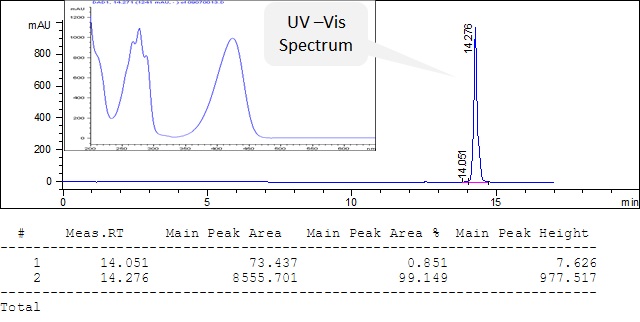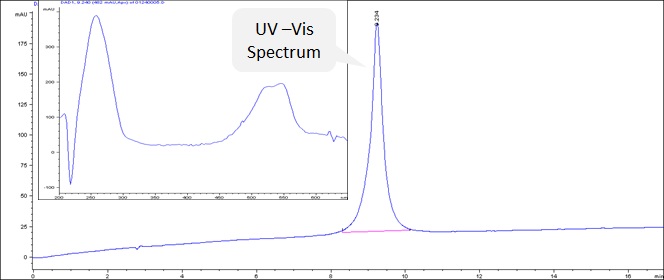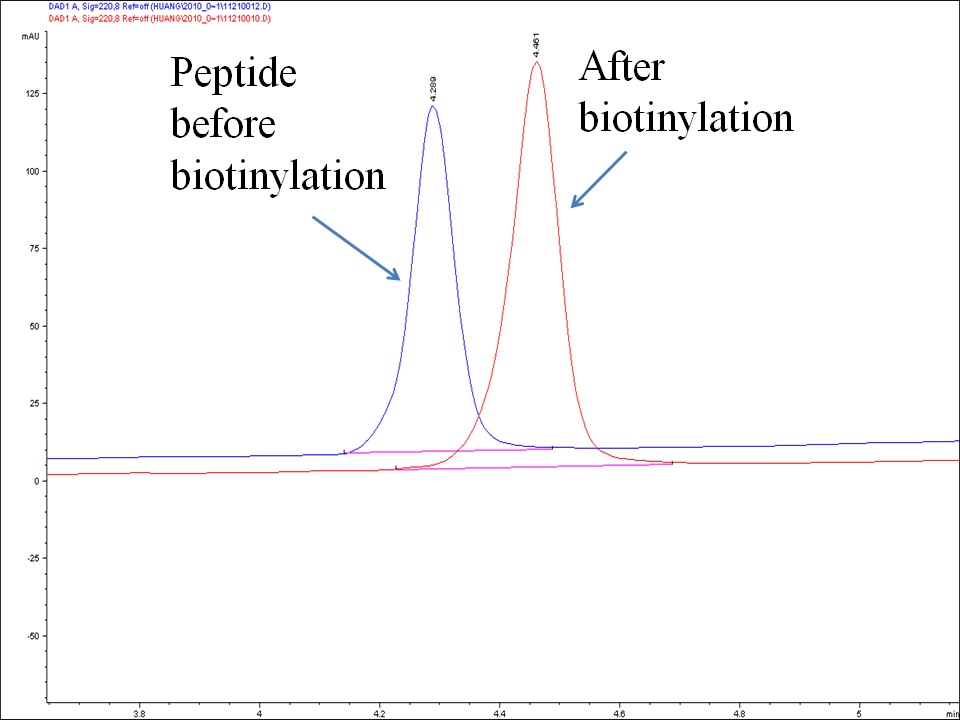Shop by Category
Shop by Brand
Shop by Brand
Custom Bioconjugation
CellMosaic started the custom bioconjugation service (CBS) since 2008. Over the years, CellMosaic has become a premier service provider and offer expertise in all bioconjugation-related services for projects with more complex chemistry or projects requiring larger product volumes or tighter specifications of the resulting final product. In particular, CellMosaic helps customers with "off the shelf" conjugation products using its advanced conjugation processes. CellMosaic has all the resources and expertise needed to fulfill such tasks, from small molecule synthesis to big molecule modification and conjugation, purification, analysis, and testing. CellMosaic takes care of the entire work flow, from molecular design to manufacturing. CellMosaic's expertise covers a wide range of small molecules and biopolymers. In a typical custom conjugation service, customers specify what kinds of molecules (either commercial or their own molecules) are to be conjugated. CellMosaic will design the molecule using commercial linkers, and then use its process to make the conjugate and supply it to the customer.
Features and Benefits of our services:
- Wide range: We offer a complete solution for biologists by sourcing (internally or externally) all raw materials and assembling the final product.
- Flexibility in conjugation chemistry: CellMosaic strategically designs its conjugation chemistry around the targeted biopolymer's properties and the customer's intended use. CellMosaic generates the bioconjugate that best meets the customer's downstream research requirements.
- Quality: CellMosaic provides high quality services. We provide all of the necessary analytical data to facilitate the customer’s understanding of the product.
Typical Examples of Custom Bioconjugation Service We Offer:
Antibody Production Tools (Hapten-Carrier): CellMosaic provides hapten–carrier bioconjugation services for antibody production. Typical haptens include proteins, peptides, oligonucleotides, and small molecules. Typical carrier proteins are keyhole limpet hemocyanin (KLH), bovine serum albumin (BSA), and ovalbumin. At the customer's request, CellMosaic can also use synthetically designed organic molecules or natural polymers as carriers.
Assay Development Tools: Whether you are using a commercial detection kit or developing an assay, chances are you may need to synthesize some of your own reagents. CellMosaic provides a variety of assay development tools for your convenience. Some examples of the assay development tools we offer are fluorescent/colorimetric labeled biopolymers, antibodies/proteins labeled with biotin, antibodies/proteins labeled with enzyme, and peptide or nucleic acid conjugates. Typical enzymes used in a detection system are horseradish peroxidase (HRP), alkaline phosphatase (AP), and glucose oxidase.
Protein Labeling and Conjugation: The most common functional groups targeted for bioconjugation on a protein are hydroxyl (present on Thr, Ser, and the phenolic group in Tyr), carboxylic acid (present at the C-terminus and on Asp and Glu), sulfhydryl (present on Cys), and amine (present at the N-terminus and Lys). Histidine's imidazolyl nitrogen and arginine's guanidinyl groups can also be targeted, but are less commonly used. Most proteins have multiple copies of the same amino acids, and conjugation chemistry targeting the functional groups of natural amino acids can result in heterogeneous bioconjugates. To specifically label a protein site, an orthogonal functional group can be introduced into the system. So far, the most popular approach uses Cys incorporation by mutagenesis. At CellMosaic, we are experts in dealing with Cys mutant proteins and labeling them with different molecules. Alternatively, if the protein is glycosylated, it can be site-specifically labeled at its glycosylation site. In general, the hydroxyl groups on adjacent carbon atoms of carbohydrates are oxidized to generate formyl groups. At CellMosaic, we have different linkers and molecules that can be synthesized to specifically react with the formyl group under very mild conditions. The less controllable approach for obtaining homogeneous protein conjugates is through manipulation of the reaction conditions in combination with the purification method(s).
At CellMosaic, we carry some labeled proteins, please click here to check some of our products.
We also carry Personalized Conjugation Kits (PerKit™) for protein labeling and conjugation, please click here to check our PerKit™ protein labeling and conjugation kits.
For large scale or project beyond the scope of PerKit™ configuration, please contact us for a quote.
Enzyme Labeling and Conjugation: Similar to any other protein, enzyme labeling is usually non-specific and performed through the surface amines, acid, or phenolic groups. Some enzymes have special properties and can be taken advantage of for bioconjugation. By manipulating the reaction conditions and purification methods, single or homogeneous enzyme bioconjugates can be obtained.
At CellMosaic, we carry some labeled enzymes, please click here to check some of our products.
We also carry Personalized Conjugation Kits (PerKit™) for enzyme labeling and conjugation, please click here to check our PerKit™ enzyme labeling and conjugation kits.
For large scale or project beyond the scope of PerKit™ configuration, please contact us for a quote.
Nucleic Acid and Oligonucleotide Labeling and Conjugation: The modification and conjugation of nucleic acids and oligonucleotides is quite different from other biopolymers, as they are rather inert to common bioconjugation reagents and conditions. Although there are reagents that can modify the base units, base modification may affect the binding capacity or propensity of nucleic acids and oligonucleotides. Many biopolymers cannot withstand the final basic cleavage conditions of solid phase oligo synthesis, so oligo bioconjugation usually is done in solution after oligo synthesis. On the other hand, small molecules may be incorporated into the oligo during oligo synthesis. Oligos are generally modified first with extra functional groups suitable for bioconjugation at the 5’ or 3’ end during oligo synthesis. Some popular 5’ or 3’ modifications for oligos are amine, thiol, and phosphate. Oligonucleotides can also contain modified bases and biomolecules conjugated at the modified base. CellMosaic offers versatile oligonucleotide labeling and conjugation strategies, depending on the application of the product.
At CellMosaic, we carry Personalized Conjugation Kits (PerKit™) for oligo labeling and conjugation, please click here to check our PerKit™ oligo labeling and conjugation kits.
For large scale or project beyond the scope of PerKit™ configuration, please contact us for a quote.
Peptide and Peptidomimetic Labeling and Conjugation: At CellMosaic, we offer custom synthesis of natural peptides, as well as modified peptides such as peptidomimetics, peptides with orthogonal functional groups, fully protected peptides, chimeric peptides, fluorescent or biotin-labeled peptides, peptide–oligo conjugates, and peptide-antibody/protein/enzyme conjugates. We use peptide synthesizer for milligram to gram scale synthesis. In order to obtain the highest quality, all of our peptides are synthesized using the most efficient HATU or HCTU coupling reagent, in contrast to the less efficient HBTU generally used by other peptide houses to reduce costs. We use an Fmoc peptide protocol with modifications deemed necessary to make the highest quality racemization-free peptide.
At CellMosaic, we carry some peptides and modified peptides, please click here to check some of our products.
We carry Personalized Conjugation Kits (PerKit™) for peptide labeling and conjugation, please click here to check our PerKit™ peptide labeling and conjugation kit.
For large scale or project beyond the scope of PerKit™ configuration, please contact us for a quote.
Fluorescence Labeling: Fluorescence technologies have been widely used in the diagnostic and detection fields, for drug screening and discovery, and as life science research tools. They rely on the excitation of the electrons of a fluorescent compound by UV light and the emission of light at a lower energy. Two types of fluorescent compounds are often used for bioconjugation: small organic fluorescent compounds, such as fluorescein, and fluorescent proteins that contain a covalently bound chromophore, such as phycobilliprotein. Both types can be used to label antibodies, proteins, and other biomolecules for detection purposes. Most of the common fluorescent compounds are very hydrophobic and not very stable. At CellMosaic, we have extensive experience in synthesizing fluorescent compounds and conjugating fluorescent compounds to biomolecules. We can help customers with any special fluorescent labeling needs.
At CellMosaic, we carry some fluorescent labeled products, please click here to check some of our products.
For large scale or project beyond the scope of PerKit™ configuration, please contact us for a quote.
Example 1: High quality fluorescent-labeled cyclic peptide synthesized at CellMosaic.

Example 2: High quality fluorescent-labeled peptide-oligo conjugate synthesized at CellMosaic.

Biotinylation: Biotin, also called vitamin H, is a coenzyme that participates in the metabolism of fatty acids, leucine, and glucose. It binds noncovalently to streptavidin and avidin with high affinity and specificity. The avidin–biotin interaction is the strongest noncovalent protein–ligand binding force known (Ka=1015 M-1). The avidin–biotin interaction has been widely explored in biotechnology for protein purification and detection. The process of attaching biotin or a biotin analog to a biomolecule is called biotinylation. A very hydrophobic molecule, biotin has to be dissolved in organic solvent prior to any bioconjugation reaction in aqueous buffer. Furthermore, excessive biotinylation of a biomolecule, such as protein, can cause aggregation. There are a variety of ways to control the biotinylation of proteins. The carboxyl group of the biotin is usually modified to suit conjugation needs without affecting biotin function.
At CellMosaic, we carry some biotin labeled products, please click here to check some of our products.
For custom biotinylation, please contact us for a quote.
Example: Clean synthesis of a biotinylated peptide on solid phase at CellMosaic.


